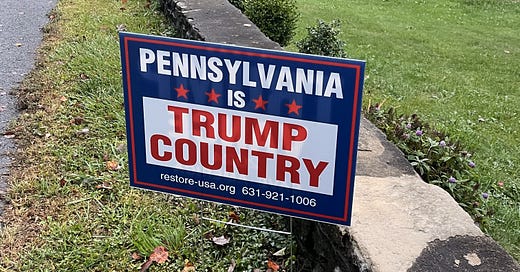An Update On President Trump’s Early Voting Progress In Pennsylvania
Why The Keystone State Is “Key” To Secure Victory This Year
Please consider upgrading your subscription here, or subscribe to my Newsletter if you have not done so already, to help me keep producing content of the highest possible quality. Your financial contributions, whether via an annual or monthly subscription or gift, are greatly appreciated and truly go a long way to helping me keep my writings available to everyone, free of charge. Thank you in advance for your generosity! God bless!
We are now within the 40-day window until Election Day – and all eyes are on the Keystone state. Over the next couple of weeks, both President Trump and Senator JD Vance have multiple rallies scheduled in Pennsylvania, including one in Butler County scheduled for October 5th. There the President will make his much-anticipated return to the town in which he nearly lost his life three and a half months ago. The time between the fated Butler rally in July and the President’s return trip is 84 days, more than twice the period of time left until November 5th.
So the clock is really ticking.
As of today, to the extent mainstream polling at all can be trusted (not much) the President would garner over 270 electoral college votes, and hence, win the presidency. This of course will all depend on the President keeping a safe lead ahead of Kamala Harris in each one of the critical “sunbelt” battlegrounds of Arizona, Georgia, and North Carolina – and either winning Nevada, where he is currently ahead, and Nebraska’s third congressional district, where polls suggest he lags, or taking Pennsylvania, a “tossup” rapidly trending rightward.
The Official Trump Watch Collection is here, and these Watches are truly special — You’re going to love them. Would make a great Christmas Gift. Don’t wait, they will go fast. GET YOUR TRUMP WATCH RIGHT NOW! Go to gettrumpwatches.com/.
Of course, there are multiple ways to 270 (and beyond) for President Trump, which includes crisscrossing through Wisconsin and Michigan, both key to his 2016 victory over Hillary Clinton – or picking off a longshot state like Virginia, Minnesota, New Hampshire, or potentially New Jersey or New York, all states that have been largely written off by pollsters and thus have scant data, but could nevertheless be ripe territory for an upset.
All that said, however, given the lack of polling in those other states, we are reduced to mere speculation. And speculation, at this late stage, deals with far too many unknown unknowns to pin down a winning strategy – at least from the standpoint of political forecasting, especially with this little time left.
Granted, forty days in politics is tantamount to many lifetimes. But, as it stands, Pennsylvania has already begun issuing applications for mail-in ballots, and at least nine of sixty-seven counties statewide have even commenced early voting – and a few of those counties, including Philadelphia, have even opened the doors to early, in-person voting.
Accordingly, we have a ton of data already to crunch about Republican performance and can compare these data sets with 2020’s final results to determine whether Donald Trump can expect to see, at this still early date, positive trends in his favor.
A few numbers already stand out: voter registration efforts by on-the-ground grassroots activists, like Scott Presler, and organizations, including the RNC and TPUSA, have made inroads in chipping away at that once formidable lead the Democratic Party commanded not too long ago in the Keystone state.
Based on official data reported by the Commonwealth of Pennsylvania, back in 2020 registered Democrats outpaced registered Republicans 4,228,888 (46.52%) to 3,543,070 (38.97%), with another 1,319,004 (14.51%) of voters remaining unaffiliated. Today, so far, the Democratic advantage has been cut to 3,933,706 (44.02%) against 3,595,310 (40.23%) for Republicans – a 3.76% reduction (with ‘other’ voters tallying 1,408,063, or 15.76%, of the remaining registered voters). Those trends obviously bode well for President Trump, who “lost” the Keystone State to Biden in 2020 by just 1.2% points (in other words, the current number passes the “too big to rig” test) and won the state by 0.7% against Hillary Clinton four years earlier.
National polling currently gives Kamala Harris a stingy 0.8% edge in Pennsylvania, though the presumption that that number is artificially boosted by older polling rests on solid footing. The latter polls gave the vice president a gratuitous boost based on false and debunked media narratives concerning Kamala’s debate performance. More recently, reputable polling either has President Trump tied with Kamala Harris in Pennsylvania or even gives him a slight lead – a phenomenon that is slowly but surely acclimating to the on-the-ground truism that Pennsylvania is, incontrovertibly, Trump Country.
For comparison, as of this date – approximately forty days out from election day – Biden enjoyed a 4.7% overall polling advantage over President Trump in 2020, while Hillary Clinton benefited from a 2.4% lead at this stage in 2016. Indeed, this should be noted with the caveat that cross-election comparisons are an imprecise science since pollsters tweak their methodologies year-to-year. In addition, one is also dealing with different pollsters election year over election year, meaning an entirely separate set of data and calculations, resulting in an ersatz cross-reference.
The other overriding factor in place that helps account for why many polls have the two candidates tied in Pennsylvania, rather than giving the President the outright lead he actually has is due to inherent bias. Each year the polls – particularly the ones self-selected by legacy outlets like the New York Times and CNN – are driven by the same subversive motive: to boost the Democratic candidate, whoever that might be, against the perennial bogeyman in Donald Trump. Mainstream pollsters are generally deemed “reputable” insofar as they do not deviate too far from preferred, if unspoken, expectations by their legacy media handlers. Ergo, the current scenario in which at least four polls, concomitantly afraid to anoint Trump with the lead he truly has, each instead indicating the race in Pennsylvania is “tied.” More on that in a moment.
Betting markets, like Polymarket, have reflected broader momentum trending in the 45th President’s favor. Recently, the popular prediction platform gave the President a slight lead in tossup battlegrounds like Pennsylvania and Nevada, which has led to him tightening his overall prospects of winning the electoral vote, according to these platforms, considerably in the past week. In summary, this confirms two major takeaways: 1) the Keystone State is the ‘key’ battleground; and 2) this race is President Trump’s to lose: he has the upper hand and should run with it.
Having said that, to declare victory this early on would of course be foolish. As Steve Bannon said in a recent op-ed, we must put “everything we have into these final weeks.” Republicans – through the relentless work of many grassroots activists and groups – have gone a long way towards correcting longstanding disparities in Pennsylvania, but in absolute numbers they remain behind (less encouraging is the fact that as of this date, Republican ballot absentee requests are at 26.45%, up by just 1.37% from 2020). The Democratic machine there, as anywhere else, spearheaded by Kamala henchman Josh Shapiro, is robust and will resort to any means to try to cheat the system once again.
Check out Kalshi, the brand new American-made prediction market for all things politics, economics, culture, Crypto, Tech, and so much more!
And, as alluded to above, in politics public perception matters just as much (if not more so) than the facts themselves. This proved true four years ago when judges and courts across the nation decided to not take up cases of election fraud, despite the overwhelming evidence that existed, citing hackneyed excuses like “a lack of standing” to circumvent the controversial issue. This was driven by legacy media narratives that ran wild with the conspiracy theory that Donald Trump was plotting to “overturn” (a word neither he nor anyone close to him ever used) the legitimate results of the 2020 presidential election. Rather than report on the accurate claim that he – and those like Jeff Clark and John Eastman who faithfully carried out their duties – was merely exercising his Article II constitutional prerogative, as commander-in-chief, to take care that the election laws were being conducted properly and legitimately. These solemn duties are ultimately grounded in the higher principle that credible elections are essential to democratic governance.
To achieve credibility, the public must have the belief that their elections have not been corrupted by fraud. Without confidence in the electoral process, the government, rightly or wrongly, will be ensnared by the perception of illegitimacy – if the belief persists long enough and becomes widespread throughout the body politic, as has occurred under the Biden-Harris administration, it starts corroding the president’s credibility like a cancer where governance then becomes impossible. At which point, the president is reduced to two options: either step down and return political power to the people, where it belongs, by ensuring a free and fair electoral process, or spurn the people entirely and rule as a tyrant. It is a regrettable though irrefutable fact that Biden (and now Harris) has chosen the latter option.
Finally, in closing, I would like to repost an excerpt from a piece I released last week, detailing Pennsylvania’s outsized importance this year and why I believe the Keystone is all-important to securing President Trump’s path back to the White House:
A Word On Pennsylvania…
Which brings me again to Pennsylvania, the aptly nicknamed Keystone State, which will prove “key” to determining the outcome of this year’s race. The subject of Pennsylvania and its role in this year’s election is a Herculean one, one deserving of an entire piece all of its own. Its importance lies in three major reasons: 1) Pennsylvania boasts the largest number of electoral votes of the seven deemed “critical” battleground states this year at 19; 2) of the three ‘blue wall’ states that handed Donald Trump the presidency in 2016, it has consistently trended more in his favor by national polling than either Michigan or Wisconsin (which lag only slightly behind) — being more demographically favorable, with large swaths of older, blue collar white voters — than the national average; and 3) of any state in the union, Philadelphia is arguably “ground zero” for voter fraud, and the most corrupt election precinct in the country, a trend that goes back decades.
To put things into context, the President can afford to lose Wisconsin, Michigan, and Arizona – a whopping 36 electoral votes – and still win the election if he secures the Keystone State (assuming that he holds Georgia, North Carolina, and Nevada, three sunbelt states that he has constantly lead all this year and still does today). By contrast, if the President loses all three of the key rustbelt battlegrounds – he would have to win Arizona, Georgia, North Carolina, and pick off a state like Virginia (which should not be written off entirely, based on the strong electoral reforms Governor Youngkin enacted this year to help fortify election integrity there, coupled with recent polling that places Trump within the margin of error among Virginian voters). In the latter scenario, he can still afford to lose Nevada, but the point that it would be more difficult to win the presidency without Pennsylvania should be obvious. (There is another scenario, where, hypothetically, President Trump can “lose” Pennsylvania, Wisconsin, Michigan, and Arizona – but would need to win Virginia, New Hampshire, Georgia, North Carolina, and hold onto Nevada, in addition to winning Nebraska’s at-large congressional district. But that scenario deals in too many implausible hypotheticals – the prospect of losing every rust belt state plus Arizona, where he presently leads, and then picking off Virginia and New Hampshire, that it is not worth giving serious merit to.)
This hypothetical electoral college map, where President Trump can afford to Wisconsin, Michigan, and Arizona, but retains Pennsylvania and the other three critical sunbelt battlegrounds of North Carolina, Georgia, and Nevada (alternatively, GA and NC can also conceivably turn blue and the Trump victory result would still hold if he adds AZ, but he would need all three of NC, GA, and AZ to lose NV), demonstrates the Keystone State’s outsized importance to 45’s prospects of becoming 47.
All of which is to reiterate the “key” in “Keystone.” More specifically, the RNC must devote serious election integrity resources and legal “boots on the ground” in Pennsylvania. Ideally, the playbook for Pennsylvania should be distinct from that used in other states. Pennsylvania’s election rules are ostensibly far more ambiguous (i.e., more room for interpretation and potential sabotage by creative lawyering) than other states, which specify, for instance, greater specificity and detail in their procedures that must take place to process mail-in ballots, including the requirement of showing identification in the form of a driver’s license or passport, or matching one’s signature with a registrar of state voters. So far, it is unclear just how election integrity lawyers will be able to verify a voter’s residence in Pennsylvania, especially if voter rolls are not publicly available. Again, the predominant issue is illegal alien voters appearing on voter rolls – and the mistrust of the public in lawmakers like Pennsylvania Governor Josh Shapiro, a Kamala Harris crony, who will doubtlessly do everything in his power to guard those state voter rolls from becoming disclosed, given his vested interest in Kamala’s election.
Beyond that, Pennsylvania lawyers should come equipped with rigorous knowledge in Pennsylvania election law, and deploy that knowledge, enforcing the law wherever needed, in the most important precincts in that all-important battleground – like Philadelphia County, neighboring Bucks County, or Delaware County – all of which house some of the biggest populations in the entire state, and thus are especially ripe for corruption and fraudulent activity, being under the thumb of Democratic officials, many of whom are Soros-aligned or DNC-funded.
An ideal strategy would be one that combines maximum knowledge of the law combined with a focus of being deployed on the ground, weeks in advance if need be, to thoroughly peruse the highest-risk precincts, and challenge fraudulent cases ahead of time. Being on the ground will also allow lawyers and other RNC personnel, such as poll monitors, to better get a lay of the landscape, and anticipate possible fraud – or the ways in which fraud might be attempted this cycle – and design a proactive strategy to mitigate, or eliminate, fraud before it occurs. It will also give RNC personnel a sense of what and who they are dealing with on the ground – providing opportunities, if all else fails, to shine the national media spotlight on bad-faith actors, before November 5th, using the light of transparency afforded by media outlets as a powerful antiseptic against fraud and unlawful conduct. The goal has always been to create a deterrent effect for bad-faith actors who would otherwise like to manipulate and interfere with this election cycle in particular to block President Trump from ever entering the Oval Office again.
But in a situation where the fate of the country literally hangs in the balance, the highest possible stakes literally ever for a presidential election, a proactive approach that works to guard the vote in a critical battleground that has already begun early voting will be absolutely essential to protect the integrity — nay, sanctity — of America’s institutions – and save democracy from the demonic forces looking to bury it once and for all.
Get your ‘Honk For Trump’ and other amazing MAGA law signs and campaign paraphernalia today!
Become a member the newly overhauled Italian American Civil Rights League (“IACRL”) today – fighting to preserve Columbus Day and our sacred traditions!
Order your Patriot Cigars today at mypatriotcigars.com and use Promo Code: TRUMPWON for 15% OFF!
A slightly modified version of this piece was originally published in The Gateway Pundit, and can be found here.
Paul Ingrassia, a graduate of Fordham University and Cornell Law School, is an Attorney; Communications Director of the NCLU; a two-time Claremont Fellow, and is on the Board of Advisors of the NYYR Club and the Italian American Civil Rights League. He writes a widely read Substack that is regularly posted on Truth Social by President Trump. Follow Paul on X @PaulIngrassia, Substack, Truth Social, Instagram, and Rumble.













I’m guessing that the 92,000 Amish in Pennsylvania aren’t included in any polling.
https://amishamerica.com/pennsylvania-amish/